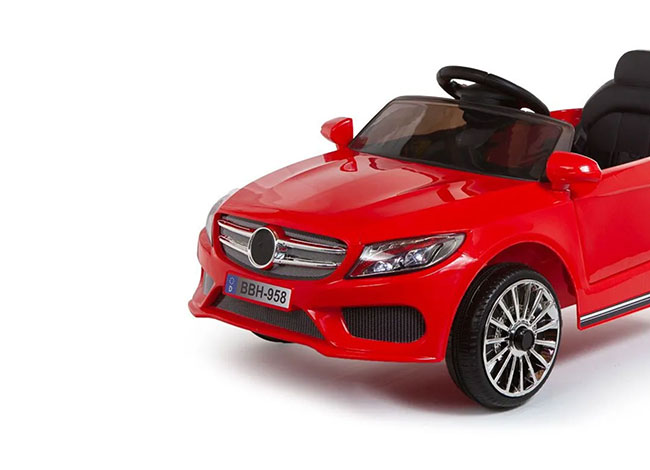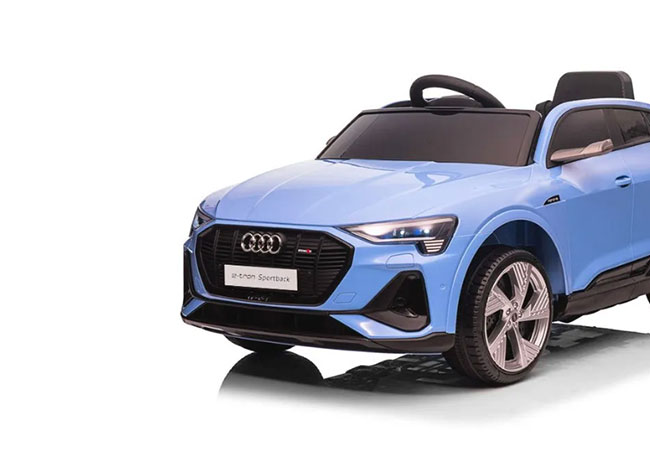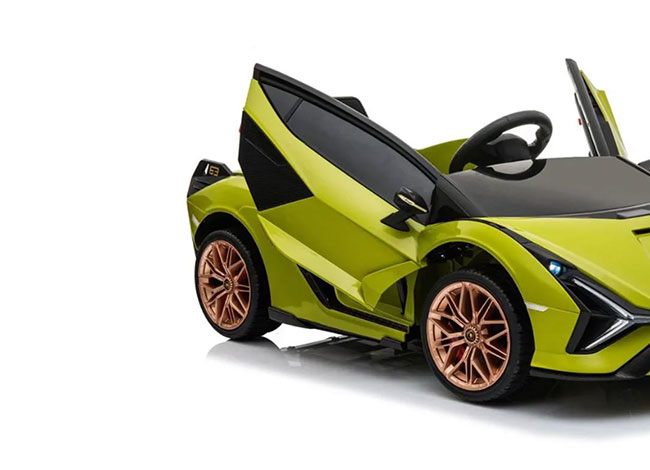When it comes to ride-on cars, a crucial component that often goes unnoticed is the lead-acid battery powering the toy. The unsung heroes behind hours of joyful rides, understanding the ins and outs of these batteries can help keep your kids’ adventures rolling for longer!
Whether you’re a seasoned ride-on car enthusiast or new to the world of battery-powered toys, this handy guide will help you with all the knowledge you need, from how lead acid batteries work to tips on maintaining and prolonging their battery life.
What’s in this guide
- What is a lead acid battery?
- How does a lead acid battery work?
- How much lead is in a lead acid battery?
- What is a flooded lead acid battery?
- What happens if a lead acid battery runs out of water?
- How to check lead acid battery water level
- How to refill lead acid battery
- How to charge a lead acid battery
- What gas is produced when charging a lead acid battery?
- What is a common result of deep-cycling a lead acid battery?
- How long does a lead acid battery last?
- How long will a lead acid battery last if not used?
- How to test a lead acid battery
- How to bring a dead lead acid battery back to life
- How to tell if a battery is lead acid or lithium
- How to convert a lead acid battery to lithium ion
- Where to recycle lead acid battery
- Lead acid battery faults and how to fix them
- A lead acid battery is a rechargeable battery consisting of lead plates.
- A lead acid battery works due to a chemical reaction between lead plates and sulfuric acid.
- A lead acid battery can contain between 5 and 20+ pounds of lead.
- A flooded lead acid battery is a rechargeable battery containing a liquid electrolyte.
- If a lead acid battery runs out of water, the battery’s capacity is reduced.
- When a lead acid battery charges, hydrogen and oxygen gases are produced.
- Deep-cycling a lead acid battery will reduce its battery life.
- A lead acid battery lasts 3 to 5 years.
- Lead acid batteries can be recycled at local recycling centres, via retailer take-back programs or by environmental organisations.
What is a Lead Acid Battery?
A lead acid battery is a rechargeable battery consisting of lead plates (positive plates made of lead dioxide and negative plates made of pure lead) and an electrolyte (a diluted sulfuric acid solution).
Lead-acid batteries were invented in 1859 by French physicist Gaston Planté. They were the first type of rechargeable battery and quickly gained popularity due to their ability to provide reliable power.

Initially used in telegraphy and railway signalling, their applications expanded with the advent of automobiles in the late 19th and early 20th centuries.
Over the years, advancements in design and manufacturing have improved their efficiency, safety, and lifespan, making them a popular choice for various uses, including in kids’ ride-on cars.
How Does a Lead Acid Battery Work?
A lead acid battery works due to a chemical reaction between the lead plates and the sulfuric acid. The reaction produces lead sulphate on both plates, releasing electrons and creating an electric current that powers the ride-on toy. The process reverses when you recharge the battery — the lead sulphate on the plates converts back into lead dioxide and pure lead, restoring the sulfuric acid concentration.
These durable batteries are ideal for children’s ride-on toys. They handle frequent charging and discharging cycles well, provide a steady current for optimal car performance, and include features to prevent overcharging and overheating. The battery’s weight also helps maintain the ride-on’s balance and stability, contributing to safer playtime for your child.

How Much Lead Is in a Lead Acid Battery?
The amount of lead in a lead acid battery varies depending on its size and type. For example, a small 12-volt lead-acid battery commonly found in kids’ ride-on cars contains 5 to 10 pounds (2.3 to 4.5 kilograms) of lead. In comparison, larger automotive batteries often exceed 20 pounds (9 kilograms).
Lead is used in the battery’s plates, with lead dioxide in the positive plates and spongy lead in the negative plates. The large quantity of lead also contributes to the battery’s overall weight, making lead-acid batteries heavier than other types, such as lithium-ion.

Due to lead being a heavy metal, properly recycling these batteries is crucial to prevent environmental contamination and health risks. Plus, recycling programs recover the lead from used batteries and reuse it in new ones or other products, thus reducing the need for mining.
What is a Flooded Lead Acid Battery?
A flooded lead acid battery is a rechargeable battery containing a liquid electrolyte, a mixture of sulphuric acid and water. This liquid fully immerses the battery’s lead plates, enabling the chemical reactions that store and release electrical energy.
Remember to keep flooded batteries upright to avoid spills and leaks. You must also periodically check the electrolyte levels and add distilled water when necessary to ensure the lead plates remain submerged. These battery types should be charged in a well-ventilated area to prevent the gases (hydrogen and oxygen) produced from building up and becoming hazardous.

However, when correctly maintained, these batteries offer reliable performance, providing consistent power for your little one’s ride-on car adventures. Plus, they are more affordable than other lead-acid battery options!
What Happens If a Lead Acid Battery Runs Out of Water?
If a lead acid battery runs out of water or the level drops too low (particularly in a flooded type), the concentration of sulfuric acid increases, reducing the battery’s capacity to hold and deliver charge. Insufficient water in the electrolyte can also lead to overheating, exacerbate sulphation, corrode the battery’s internal components and expose parts of the plates to air, causing oxidation.
To prevent your lead acid battery from drying out, regularly check and maintain the water level, and use distilled water to top off the electrolyte instead of tap water, which can introduce impurities and cause additional harm.

How to Check Lead Acid Battery Water Level
To check lead acid battery water level, locate the battery in your child’s ride-on car, typically under the seat or hood, and disconnect it from the device to prevent accidental short circuits. Then, carefully remove the cell caps to access the inside of the battery. If these are sealed, the battery is a maintenance-free type and doesn’t require water level checks.
Inspect each cell to check the electrolyte level, using a flashlight to get a clear view if necessary. The ideal level is usually just below the bottom of the vent well or the plastic lip, which indicates the maximum fill line.

How to Refill Lead Acid Battery
To refill a lead acid battery, put on protective gear, including gloves and safety goggles, and then open the caps to check the electrolyte levels. As mentioned above, the solution should cover the battery’s plates without being overfull.
If the electrolyte level appears low, carefully pour distilled water into each cell, ideally using a plastic funnel or a container with a narrow spout to control the flow and prevent spills. Fill the cells until the water level reaches just below the bottom of the vent well and the plates are fully submerged. Do note that overfilling can cause the electrolyte to flow over during charging, leading to acid spills.

Once the cells are filled to the appropriate level, securely replace the caps to prevent dirt and contaminants from entering the battery. After refilling, it’s a good idea to fully charge the battery, especially if the electrolyte level was significantly low. Charging ensures the electrolyte is suitably mixed and the battery is ready for use.
How to Charge a Lead Acid Battery
To charge a lead acid battery, choose a compatible charger that matches its voltage (e.g., 6v, 12v, or 24v) — a smart charger with automatic shutoff and trickle charge modes is perfect!
Connect the charger by attaching the positive cable (red) to the positive terminal and the negative cable (black) to the negative terminal. Ensure all connections are tight and secure to prevent sparking. Set the charger to the appropriate mode based on the battery’s condition and your charging needs, and use a low amperage setting for optimal charging. Slow charging is gentler on the battery and helps extend its lifespan.


Periodically check the charger’s display or indicator lights to monitor the charging progress. Most smart chargers automatically shut off when the battery’s charge is complete. But if you’re using a manual charger, you’ll need to keep an eye on the voltage to prevent overcharging.
Then, turn the charger off and disconnect the cables, starting with the negative cable and then the positive. Ensure the battery is clean and dry before returning it to the ride-on toy.
What Gas is Produced When Charging a Lead Acid Battery?
The gases produced when charging a lead acid battery are hydrogen and oxygen. They form due to the electrochemical reaction occurring during the charging process when electrical energy decomposes the water in the battery’s electrolyte solution.
Hydrogen gas is produced at the negative plates of the battery, while oxygen gas forms at the positive plates. This decomposition of water into hydrogen and oxygen is a normal part of the charging process, especially when the battery is near or at full charge. The chemical reaction can be summarised as follows:
2H2O → 2H2(gas) +O2(gas)

What Is a Common Result of Deep-Cycling a Lead Acid Battery?
A common result of deep-cycling a lead acid battery is reduced battery life. Repeatedly discharging the battery to a low state and then recharging it significantly impacts performance and longevity, stressing the internal components, warping the plates, and accelerating general wear and tear.
Prevent these problems by maintaining proper charging practices and avoiding complete discharges whenever possible. Regular maintenance and careful use will also help extend the battery’s lifespan and ensure your kiddo’s ride-on continues to perform effectively.

How Long Does a Lead Acid Battery Last?
A lead acid battery lasts 3 to 5 years, depending on usage. To increase longevity, regularly charge the battery (avoiding deep discharges), keep the terminals clean and corrosion-free and store the battery in a cool, dry location away from extreme temperatures.
How Long Will a Lead Acid Battery Last If Not Used?
A lead acid battery will not last long if unused for extended periods. The battery’s natural self-discharge rate causes it to lose about 1-5% of its charge per month, so the longer you leave it without recharging, the more deeply discharged the battery becomes, significantly reducing its lifespan and performance.
Plus, when a lead-acid battery sits idle for too long, lead sulphate crystals can form on the battery’s plates, a condition known as sulfation. This reduces the battery’s capacity and makes it difficult or impossible to recharge.

How to Test a Lead Acid Battery
To test a lead acid battery, perform a visual inspection, check the voltage, conduct a load test (or specific gravity test for flooded batteries), and monitor performance. Regular testing ensures the battery remains in tip-top condition and performs reliably, keeping the ride-on car’s wheels spinning and a smile on your mini motorist’s face.
Below, we explore each lead acid battery test in more detail:
- Perform a visual inspection: Look for signs of damage on the battery case, such as cracks, bulges, or leaks, and check the terminals for corrosion and buildup. For flooded lead acid batteries, inspect the electrolyte levels and add distilled water if necessary.

- Use a digital multimeter to check voltage: Set the multimeter to the DC voltage setting and connect the positive (red) probe to the battery’s positive terminal and the negative (black) probe to the negative terminal. A fully charged 12V lead acid battery should read around 12.6 to 12.8 volts. If the voltage is significantly lower, the battery may need recharging or be faulty.
- Conduct a load test: To access the battery’s ability to perform under load, connect the tester’s clamps to the battery terminals and apply a load according to the battery’s rating (typically 50% of the battery’s Cold Cranking Amps (CCA) rating). While under load, observe the voltage. A healthy battery should maintain a voltage above 9.6 volts for a 12V battery. If the voltage drops below this level, the battery may be weak or failing.
- Try a specific gravity test for flooded lead acid batteries: Using a hydrometer, draw an electrolyte sample from each cell of the flooded battery. The hydrometer’s float will indicate the specific gravity, which should range from 1.265 to 1.299. Low specific gravity readings can indicate a discharged or sulphated battery.
- Check for sulphation: If you find lead sulphate crystals on the plates, use a desulfator to break down the crystals and restore some battery capacity.
- Pay attention to battery performance: Does the battery struggle to power the ride-on toy, require frequent recharging or exhibit reduced run time? Then, it might be nearing the end of its life and will need replacing.
How to Bring a Dead Lead Acid Battery Back to Life
Reviving a lead acid battery is a handy skill to have, especially when you want to extend the life of your child’s ride-on car battery.
Follow this step-by-step guide to bring a dead lead acid battery back to life:
- Safety first!: When tinkering with a lead-acid battery, always wear gloves and goggles to protect against acid spills and ensure your workplace has adequate airflow to avoid inhaling fumes.
- Inspect the battery: Next, check the battery for cracks or leaks — it’s best to replace it if you spot any exterior damage. If the case looks intact, use a wire brush and a mix of baking soda and water to remove any corrosion on the battery terminals.

- Check the battery’s voltage: Measure the battery’s voltage using a multimeter. If it reads less than 10.5 volts, the battery is severely discharged.
- Slow charge the battery: A smart charger with a desulphation mode (a function that removes sulphate buildup on lead plates) will gradually restore the lead acid battery’s charge. Connect the charger according to the manufacturer’s instructions and let the battery charge slowly. Fast charging can generate heat and cause further damage.
- Check electrolyte levels: If the battery still doesn’t function, it might be due to low electrolyte levels. In that case, add distilled water to each cell until the plates are covered, being careful not to overfill. Another option is to try an equalisation charge using a smart charger, which balances the charge among the cells and helps restore capacity. Then, after charging, use a load tester to check if the battery can hold a charge and deliver sufficient power.
- Do regular battery maintenance: Keep the terminals clean, check electrolyte levels periodically, and charge the battery regularly to prevent it from discharging completely. Do note that reviving a lead-acid battery is not always guaranteed, and results can vary based on the battery’s condition and age. If the battery does not hold a charge after these steps, it may be time to replace it.
How to Tell if a Battery is Lead Acid or Lithium
To tell if a battery is lead acid or lithium, inspect its physical appearance and assess its weight. Lead acid batteries are typically heavier and bulkier than their lithium counterparts and have a traditional rectangular shape with larger terminals. In contrast, lithium batteries are more compact and lightweight.
Another way to determine the battery type is to check for labels or markings. Lead-acid batteries usually have “Lead Acid”, “Sealed Lead Acid”, or “SLA” printed on their casing. Lithium batteries, on the other hand, are labelled as “Lithium Ion”, “Li-ion”, or “LiFePO4”, depending on the type of lithium chemistry used.

Voltage and capacity specifications also provide clues. Lead acid batteries have a nominal voltage of 6V, 12V, or 24V and are often rated in amp-hours (Ah). Lithium batteries may have similar voltage ratings but are more energy-dense and lighter, offering higher capacities in a smaller size.
How to Convert a Lead Acid Battery to Lithium Ion
Converting a lead acid battery to lithium ion in your little one’s ride-on toy offers several benefits, including lighter weight, faster charge times, and less maintenance.
A lithium-ion battery differs from other types because it stores and releases energy by moving lithium ions between a positive electrode (cathode) and a negative electrode (anode).
Here’s how to make the conversion:

- Assess compatibility: First, ensure the lithium ion battery’s voltage matches the original lead acid battery. Most ride-on cars use 6V, 12V, or 24V battery systems. Then, check the lithium ion battery’s dimensions to ensure it fits in the existing compartment.
- Choose a suitable lithium-ion battery: Opt for a battery with a similar or higher capacity (measured in amp-hours, Ah) to ensure it provides enough runtime. It must also include a Battery Management System (BMS), a control unit that manages charging and discharging and protects it from overheating.
- Gather the necessary tools and materials: To make the swap, you’ll need the following equipment: Battery connectors matching the terminals on the lithium ion battery. Mounting hardware to secure the new battery in place. Basic tools such as a screwdriver, wrench, and electrical tape.
- Remove the old lead acid battery: Disconnect the lead acid battery’s negative terminal, followed by the positive. Next, carefully remove the battery from the compartment and check for acid spills or leaks.
- Install the new lithium ion battery: Position the lithium ion battery in the compartment, ensuring it is secure and stable, and attach the new connectors to the terminals, connecting the positive terminal first, followed by the negative.
- Secure and test the battery: Once you’ve firmly secured the battery using mounting hardware, switch on the ride-on car to test if it’s working correctly. Check for proper operation, ensuring the toy runs smoothly and the battery provides adequate power.
Where to Recycle Lead Acid Battery
Appropriate recycling of lead acid batteries, rather than throwing them in a general waste bin, is crucial because they contain lead and sulfuric acid, which can harm people and the environment. Here are the best places to recycle a lead acid battery:
- Local recycling centres: check your local government or waste management services to find a designated drop-off location equipped to handle hazardous materials near you.
- Retailer take-back programs: some shops selling batteries or electronic products accept used lead acid batteries for recycling. Contact the store where you purchased the battery to learn about their policies.

- Environmental organisations: many eco charities run programs specifically aimed at recycling batteries and other electronic waste, providing drop-off points or even mail-in options.
Lead Acid Battery Faults and How to Fix Them
Lead Acid Battery Gets Hot When Charging
A lead acid battery gets hot when charging due to the chemical reaction occurring within it as the charger forces the current through the electrolyte. The reaction converts the lead sulphate back into lead dioxide and lead, generating heat as a natural byproduct.
Charging a ride-on car battery at a high current rate produces more heat, so avoid fast charging settings and use a charger with the correct specifications for your battery.

Additionally, an ageing or poorly maintained battery may overheat due to internal resistance, sulphate buildup, or electrolyte imbalance. Regular maintenance and proper charging practices can help prevent these issues and keep the battery from becoming excessively hot.

Lead Acid Battery Making Noise When Charging
Although hearing noises from your lead acid battery as it charges can be concerning, fortunately, it’s not always a sign of a serious problem. Below are a few common causes of these noises and what you need to know about them:
- Gassing: as the battery charges (especially towards the end of the charge cycle), it produces hydrogen and oxygen gases. This process, known as electrolysis, can create a bubbling or hissing sound. While gassing is a normal part of the charging process, excessive noise might indicate overcharging or charging at too high a voltage, which can be damaging over time.
- Electrolyte boiling: a boiling sound indicates that the electrolyte inside the battery is getting too hot, often due to overcharging or using a charger that supplies too high a voltage. Boiling electrolyte can lead to a loss of electrolyte solution, reducing the battery’s capacity and potentially causing damage to the internal plates.
- Internal short circuit: sizzling or popping noises are a bigger cause for concern as this may mean an internal short resulting from physical damage to the battery, such as a cracked plate or degraded separator. This fault can cause localised heating, so stop charging immediately and have the battery inspected by a professional.
- Sulphate crystals breaking: if your lead acid battery has been deeply discharged or left unused for an extended period, lead sulphate crystals can form on the plates. These crystals can then break off during charging, creating a cracking or popping sound. While you can reverse some sulphation through careful charging, a large number of crystals can cause permanent battery damage.
- Charger issues: sometimes, the noise might not be coming from the battery but from a malfunctioning or improperly configured charger. To avoid these issues, ensure the charger is compatible with your battery and is functioning correctly.
Lead Acid Battery Bubbling When Charging
Bubbling in a lead acid battery during charging is a common phenomenon, caused by electrolysis, a process where electrical energy splits water in the electrolyte into hydrogen and oxygen gases. Bubbling typically occurs towards the end of the charging cycle and is a normal indication that the battery is nearing a full charge.
However, be aware that an undue accumulation of hydrogen is flammable, so charge the battery in a well-ventilated area to ensure the gas disperses safely.

Also, if the bubbling accompanies excessive heat, the charger might be faulty. Overheating can lead to rapid water loss in the electrolyte and cause acid stratification, where the solution becomes more concentrated at the bottom of the battery, reducing its lifespan.
About the Author
Hannah Hill
Entrepreneur, and mother of three. Hannah is a toy expert with 20+ years in the online toy industry, founding the Kidaroos website that sells 10,000+ toys per year. Hannah is always looking for new, innovative ways to keep everyone's kids active and energised in a world full of screens and social media and has been featured in publications such as Authority Magazine.


















